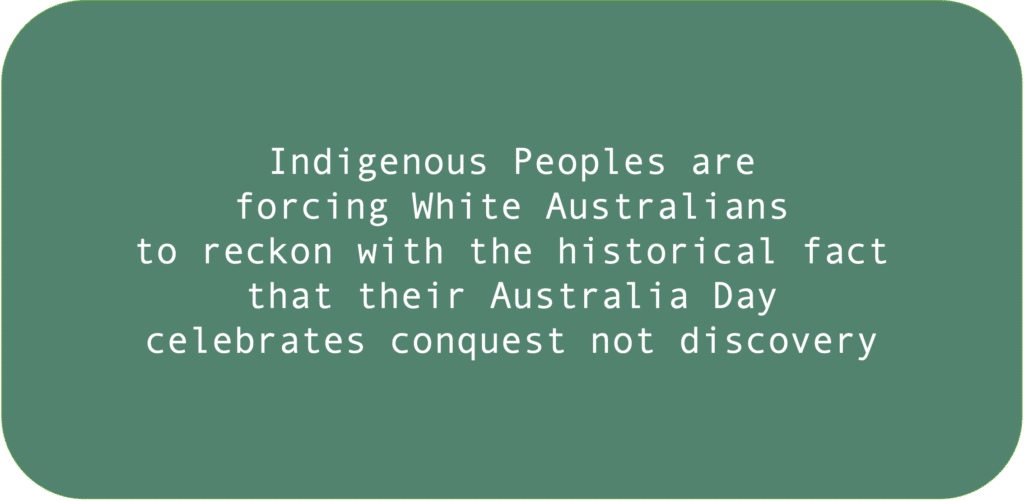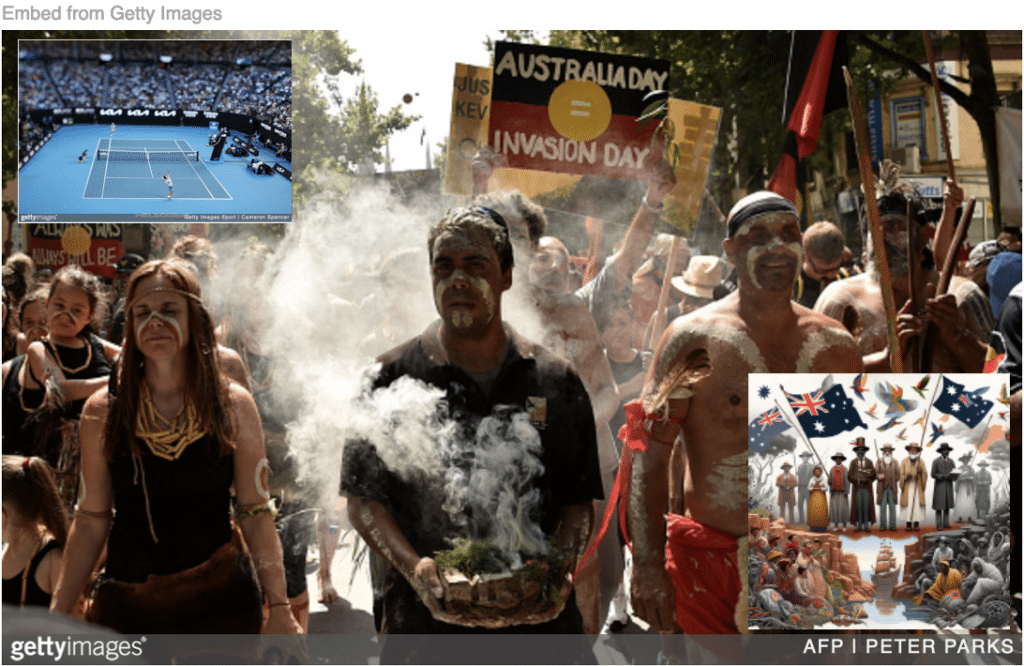 Australia Day
Australia Day
Australia Day marks the 1788 landing of White settlers who colonized the Continent. But White Australians are finally reckoning with the historical fact that their ancestors did not discover Australia.
Of course, White Americans have been facing a similar reckoning for decades. But it’s stupefying that it took Whites in America and Australia so long to recognize that their ancestors met Indigenous people already living in their respective landing places.
Rallies, smoking ceremonies and concerts are among dozens of events Australians are planning across the country for 26 January calling for Australia Day to be abolished or celebrated on a different date, celebrating First Nations survival and reflecting on reconciliation.
(The Guardian, January 24, 2024)
These events reflect the transformation of consciousness of a critical mass of Australians. They want to right the historical record so that January 26 celebrates Indigenous culture, not White dominion.
Moreover, their annual events are becoming increasingly restive and disruptive. Indeed, for the second consecutive year, they’ve upstaged the Australian Open so much that organizers didn’t even bother to mark the traditional Australia Day.
Columbus Day precedent
Young people throughout the Americas are forcing a correction of the American historical record. Columbus Day used to mark the 1492 landing of White colonizers. It was a holiday to celebrate European discovery of a new world. But it’s becoming a solemn day to commemorate European conquest of Indigenous Peoples.
Likewise, young people throughout Australia are forcing a correction of the historical record. Australia Day was a holiday to celebrate European discovery of a new colony (albeit a penal one). But it’s becoming a solemn day to commemorate European invasion Down Under.
Columbus Day is now generally known as Indigenous Peoples’ Day. And Australia Day is becoming known as Invasion Day or Survival Day. Because, like White Americans, White Australians are finally coming to terms with the untenable spectacle of taking national pride in what amounted to a cultural genocide.

My anti-Australia Day crusade
In this regard, I’ve been pricking the conscience of my White Australian friends for decades. I chastise them for continually accusing White Americans of systemic racism from their lily-white haven.
After all, White Americans had to contend with millions of restive Blacks from the days of slavery. In contrast, for far too long, White Australians could blithely ignore Indigenous Peoples – who were few in number and passive by nature. That enabled White Australians to sit rather comfortably on their high horse.
I always got under their skin, however. I did so by drawing uncomfortable but undeniable parallels between the way Whites treat non-whites in Australia and the way Whites treated non-whites in Apartheid South Africa.
Restive Indigenous Peoples
I was heartened decades ago when Indigenous Peoples began fighting for civil rights in Australia, mirroring the way Blacks fought in America. And they have been doing far more to prick the conscience of White Australians than anything I ever did.
Case in point, Indigenous Australians had their Rosa Parks moment in 1972. They marked Australia Day by setting up a tent embassy right on the front lawn of Parliament House. And they fortified it with placards demanding land reparations and sovereignty, instead of welfare handouts. They’ve been mocking Australia Day in that fashion every year ever since.
Australia Day 2012 was notable in this regard. Indigenous Peoples got word that then Prime Minister Julia Gillard was attending a ceremony nearby. So hundreds of them decamped outside the venue and began shouting their now-familiar slogan:
Always was, always will be, Aboriginal land.
- The Associated Press: Australian prime minister loses shoe fleeing angry crowd
- The Guardian: Australian prime minister is jostled by tent protesters
- The Wall Street Journal: Gillard’s lost shoe is returned amid storm over Aboriginal row
Of course, that they returned her shoe indicates that the Aboriginals were not nearly as menacing as their oppressors feared. But I even put in my two cents with “Australia’s Aboriginal Spring Has Prime Minister Running for Her Life” on January 27, 2012.
The problem, of course, is that it has been over a decade and several prime ministers since that seemingly fateful confrontation. Moreover, it has been over 50 years since indigenous peoples set up their Tent embassy. Yet the only redress they can cite is the way the Australian government emulated the Canadian government last year.
Specifically, throughout much of the 20th century, the Canadian government rounded up Indigenous children for forced assimilation at boarding schools and church-run missions. It set up a fund to compensate their families.
Never mind that the vast majority of indigenous Australians remain displaced and continue to face systemic discrimination and marginalization.
Australia Day protests: Sound and fury signifying nothing?
Regrettably, the likelihood of Indigenous Australians receiving further redress from the Australian government is bleak. They need only look to the enduring frustration of Native and Black Americans in getting further redress from the American government.
Hell, Australia is planning a national referendum on whether or not to create an indigenous advisory body just to discuss Aboriginal issues with the government. What could be more discouraging than that?
They’ve got Indigenous Peoples squatting in tents on the front lawn of Parliament House. That should be a source of even greater national shame than the sight of homeless people squatting in tents along boulevards all over California.
Yet, far from deeming their tent embassy an eyesore to be dismantled, White Australians are treating it like a tourist attraction to be appreciated. It’s like a friggin national zoo.